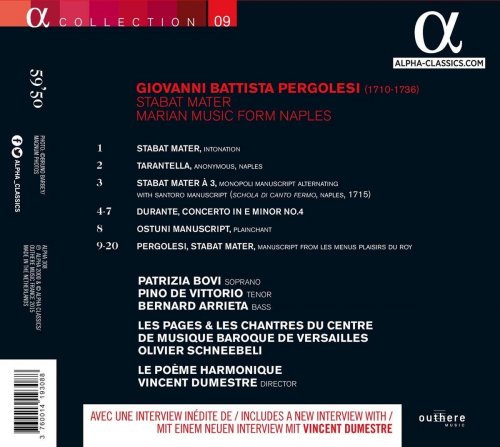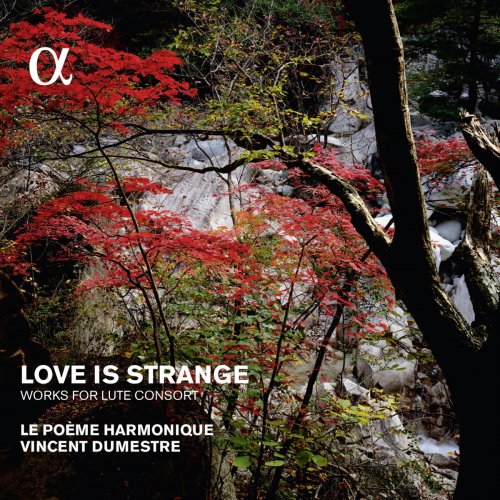
Le Poème Harmonique, Vincent Dumestre - Love is strange. Works for Lute Consort (2005)
BAND/ARTIST: Le Poème Harmonique, Vincent Dumestre
- Title: Love is strange. Works for Lute Consort
- Year Of Release: 2005
- Label: Alpha
- Genre: Classical
- Quality: flac lossless +Booklet
- Total Time: 01:01:13
- Total Size: 292 mb
- WebSite: Album Preview
Tracklist
01. Wakefilde on a Green
02. Dorick Prelude
03. Decrevi
04. Callinoe
05. Ut re mi fa sol la
06. Twenty Waies Upon the Bells
07. Irish Toy
08. Sellengers Ronnde
09. Green Sleeves
10. Spero
11. Dump
12. Lachrimae
13. Passymeasure Galliard
14. Galiarda
15. A Toy
16. Trenchmore
17. In Nomine XII -Crye-
18. Corn Yairds
19. A Gray's Inn, the First
20. Love Is Strange
21. Canaries
22. Upon la mi re

Unlike most of the music in the fabulous "ut pictura musica" series from France's Alpha label, that presented here is something of a speculative reconstruction. As one section of the complex booklet (in French and English) explains, English ensemble instrumental music of the late sixteenth and early seventeenth centuries might be played by either a "whole" (homogeneous) or "broken" (diverse) consort. "It is [the] tradition of the whole consort that we wish to revive on this recording," writes director Vincent Dumestre. But it is a specific and rather unusual kind of whole consort that he is talking аbout: one made up entirely of plucked stringed instruments and mostly of lutes. Little music of this kind has come down to the present in notated form, but literary and iconographic evidence shows that it existed, and it is supposed to have had an improvisational component. The music, here, some of it anonymous and some of it by John Johnson, Antony Holborne, John Dowland, the pretentiously named Giovanni Coprario (he was really just John Cooper), and other contemporaries, has various sources; some of it is lute music, some keyboard music, some of it instrumental music from masques or for plays, some of it dance music, some of it abstract like the In nomine pattern, and some of it representing the earliest layers of what can be called popular tunes (Greensleeves, for example), in a few cases Scottish. It has thus been imaginatively adapted for the present medium.
The notes go into the historical issues in some detail for interested listeners, but one can also just plunge into the music and be satisfied. The opening Wakefilde on a green, a set of divisions or variations by Johnson, immediately immerses the listener in a sound world like hardly anything else in Renaissance music, with a virginal (played by Pierre Hantaï, a major presence here) and a bass cittern supporting the lutes in large, sweeping, expressive waves. The music seems to violate the boundary between indoor and outdoor that prevailed in Elizabeth's time; it is dramatic and festive, yet still interior - music, perhaps, for an important event in a large hall. The forces range from a single lutenist or keyboardist to a booming group of six players, and the program, running from dances such as Johnson's Trenchmore (the name of an Irish dance) to complex intellectual exercises like the anonymous Upon la re mi, is consistently arresting. With these riches, it seems almost a surfeit to have Alpha's usual inclusion of a discussion of a painting related to the musical repertoire at hand - a portrait of a rather disdainful yet sad young nobleman who has slipped outside castle walls to think or to meet someone. The portrait is stylized, yet a feeling of melancholy seems to burst through it. Much the same might be said of the music on this remarkable album, which listeners from English music enthusiasts to total newcomers may well greet with a reaction somewhere between surprise and shock.
01. Wakefilde on a Green
02. Dorick Prelude
03. Decrevi
04. Callinoe
05. Ut re mi fa sol la
06. Twenty Waies Upon the Bells
07. Irish Toy
08. Sellengers Ronnde
09. Green Sleeves
10. Spero
11. Dump
12. Lachrimae
13. Passymeasure Galliard
14. Galiarda
15. A Toy
16. Trenchmore
17. In Nomine XII -Crye-
18. Corn Yairds
19. A Gray's Inn, the First
20. Love Is Strange
21. Canaries
22. Upon la mi re

Unlike most of the music in the fabulous "ut pictura musica" series from France's Alpha label, that presented here is something of a speculative reconstruction. As one section of the complex booklet (in French and English) explains, English ensemble instrumental music of the late sixteenth and early seventeenth centuries might be played by either a "whole" (homogeneous) or "broken" (diverse) consort. "It is [the] tradition of the whole consort that we wish to revive on this recording," writes director Vincent Dumestre. But it is a specific and rather unusual kind of whole consort that he is talking аbout: one made up entirely of plucked stringed instruments and mostly of lutes. Little music of this kind has come down to the present in notated form, but literary and iconographic evidence shows that it existed, and it is supposed to have had an improvisational component. The music, here, some of it anonymous and some of it by John Johnson, Antony Holborne, John Dowland, the pretentiously named Giovanni Coprario (he was really just John Cooper), and other contemporaries, has various sources; some of it is lute music, some keyboard music, some of it instrumental music from masques or for plays, some of it dance music, some of it abstract like the In nomine pattern, and some of it representing the earliest layers of what can be called popular tunes (Greensleeves, for example), in a few cases Scottish. It has thus been imaginatively adapted for the present medium.
The notes go into the historical issues in some detail for interested listeners, but one can also just plunge into the music and be satisfied. The opening Wakefilde on a green, a set of divisions or variations by Johnson, immediately immerses the listener in a sound world like hardly anything else in Renaissance music, with a virginal (played by Pierre Hantaï, a major presence here) and a bass cittern supporting the lutes in large, sweeping, expressive waves. The music seems to violate the boundary between indoor and outdoor that prevailed in Elizabeth's time; it is dramatic and festive, yet still interior - music, perhaps, for an important event in a large hall. The forces range from a single lutenist or keyboardist to a booming group of six players, and the program, running from dances such as Johnson's Trenchmore (the name of an Irish dance) to complex intellectual exercises like the anonymous Upon la re mi, is consistently arresting. With these riches, it seems almost a surfeit to have Alpha's usual inclusion of a discussion of a painting related to the musical repertoire at hand - a portrait of a rather disdainful yet sad young nobleman who has slipped outside castle walls to think or to meet someone. The portrait is stylized, yet a feeling of melancholy seems to burst through it. Much the same might be said of the music on this remarkable album, which listeners from English music enthusiasts to total newcomers may well greet with a reaction somewhere between surprise and shock.
As a ISRA.CLOUD's PREMIUM member you will have the following benefits:
- Unlimited high speed downloads
- Download directly without waiting time
- Unlimited parallel downloads
- Support for download accelerators
- No advertising
- Resume broken downloads


